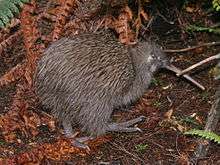New Zealand fairy tern
| New Zealand fairy tern | |
|---|---|
.jpg) | |
| Scientific classification | |
| Kingdom: | Animalia |
| Phylum: | Chordata |
| Class: | Aves |
| Order: | Charadriiformes |
| Family: | Laridae |
| Genus: | Sternula |
| Species: | S. nereis |
| Subspecies: | S. n. davisae |
| Trinomial name | |
| Sternula nereis davisae | |
The New Zealand fairy tern (Sternula nereis davisae), also known as the tara-iti,[1] is a small tern which breeds between Whangarei and Auckland in the North Island of New Zealand[2]. It is considered critically endangered with an estimated 45 individuals and 12 breeding pairs. It is the smallest tern breeding in New Zealand and is a subspecies of the fairy tern.
Breeding
Breeding is limited to four regular sites: Waipu, Mangawhai, Pakiri and the South Kaipara Head.[1] Courtship begins in September, with egg laying occurring between late October and early January. Birds typically lay 1-2 eggs per nest[2]. Nests are small unlined scrapes in the sand and are roped off and monitored by The Department of Conservation[1].
The nests are constructed near white, grey and orange shell debris to help disguise the eggs and chicks, and are found at least 1km apart from each other[2]. They are vulnerable to environmental events such as storms and high tides; predation; and human recreational activities[1]. Females spend more time incubating eggs than males, while males provide the majority of food to the chicks. The chicks are mobile from hatching, and ready to fully fledge from 30 days old[2].
The wintering range of the birds extends over the Kaipara Harbour. Outside of the breeding season fairy terns form flocks on the harbour, often around Tapora.
Conservation
The number of birds plummeted to three pairs in 1983 but intensive conservation efforts were put in place and numbers increased so that in 1998 the population totalled some 25 to 30 birds with 10 to 12 breeding pairs spread over three breeding sites. Numbers have continued to increase and by 2006 had reached 30 to 40 individuals including 12 breeding pairs. Five years later, numbers have increased again to 40 to 45 individuals and around 10 breeding pairs.[3]
With a total population of fewer than fifty individuals including just ten breeding pairs, the IUCN rates this species as "Critically Endangered".[3] A New Zealand government source considers that this bird is "probably New Zealand's most endangered indigenous breeding bird."[1] It nests on sand and shell banks just above high tide mark and nesting is highly vulnerable to introduced predators, domestic animals, storms, very high tides and disturbance by humans on foot and in vehicles on the beach. The bird is further threatened by a proposed residential subdivision at Te Arai, next to one of its prime breeding sites.[4]
References
- 1 2 3 4 5 "New Zealand fairy tern/tara-iti". New Zealand Department of Conservation. Retrieved 5 October 2018.
- 1 2 3 4 "Fairy tern | New Zealand Birds Online". nzbirdsonline.org.nz. Retrieved 2018-10-05.
- 1 2 "Species factsheet: Sterna nereis". BirdLife International. Retrieved 17 December 2013.
- ↑ Dowling, J. E. (April 2006). "Potential impacts on shorebirds of a proposed subdivision at Te Arai, North Auckland" (PDF). DM Consultants. p. 5. Archived from the original (PDF) on 4 February 2012. Retrieved 19 July 2012.
External links
- New Zealand Birds
- K. Hansen (2006). "New Zealand fairy tern (Sternula nereis davisae) recovery plan, 2005–15 (Threatened species recovery plan 57)" (PDF). Department of Conservation, Wellington, New Zealand.
- New Zealand Fairy Tern Charitable Trust
- Endangered Birds at Te Arai (Te Arai Beach Preservation Society)
- Future Problem Solving
- Fairy Tern Zoo, Meet the Locals S2 Ep29
- New Zealand fairy terns discussed on Critter of the Week, 3 February 2017

